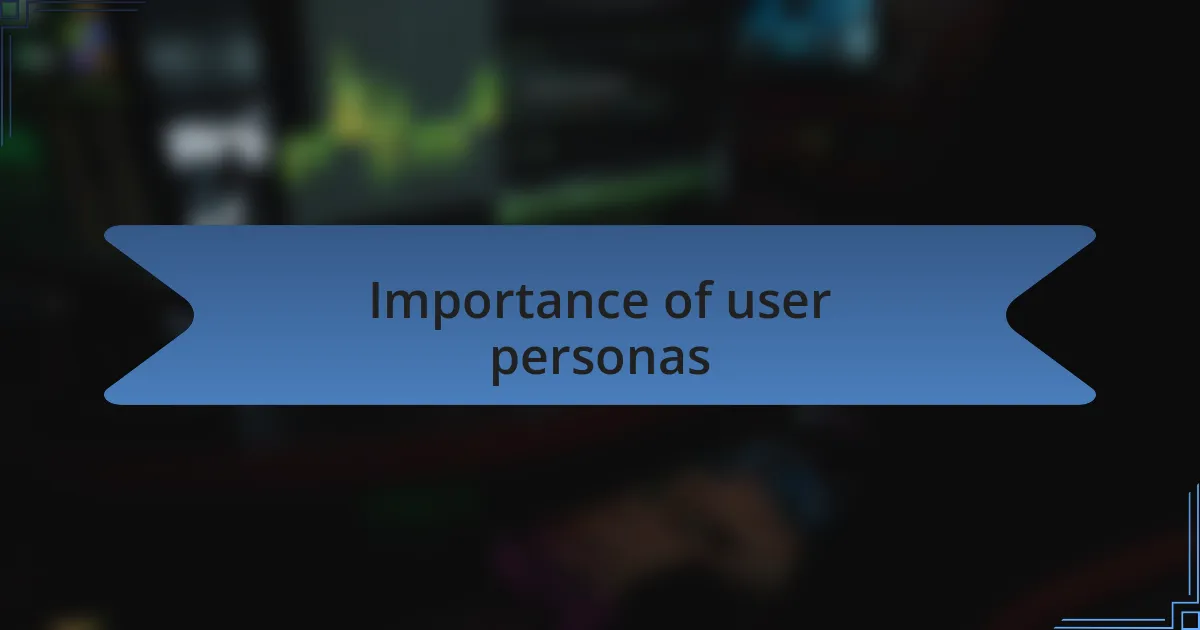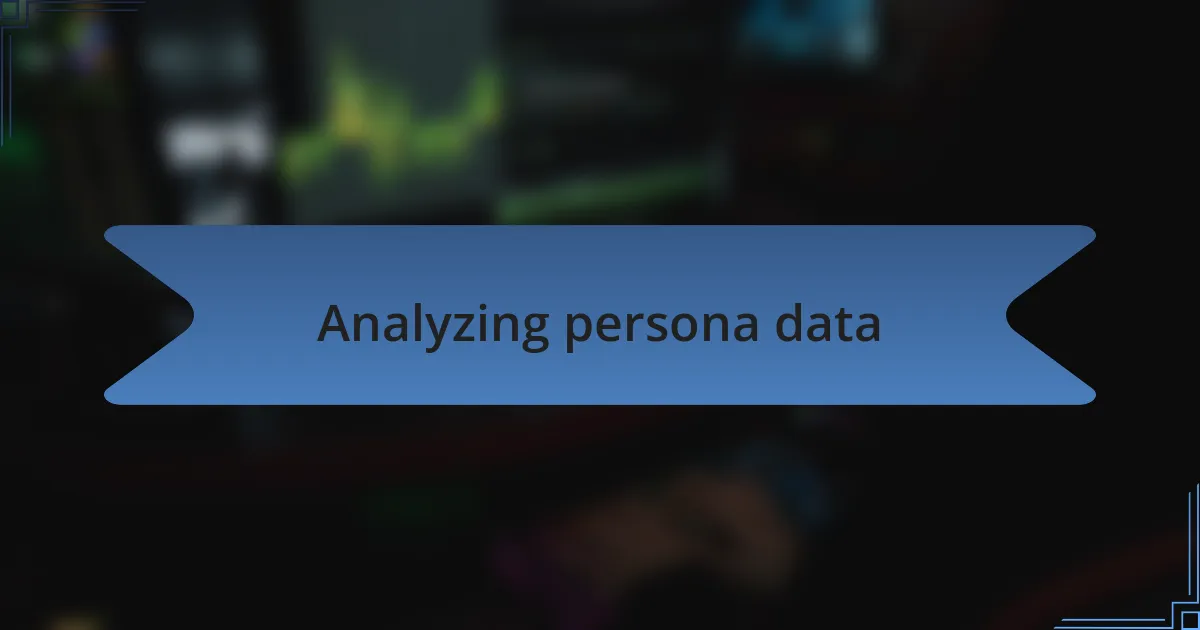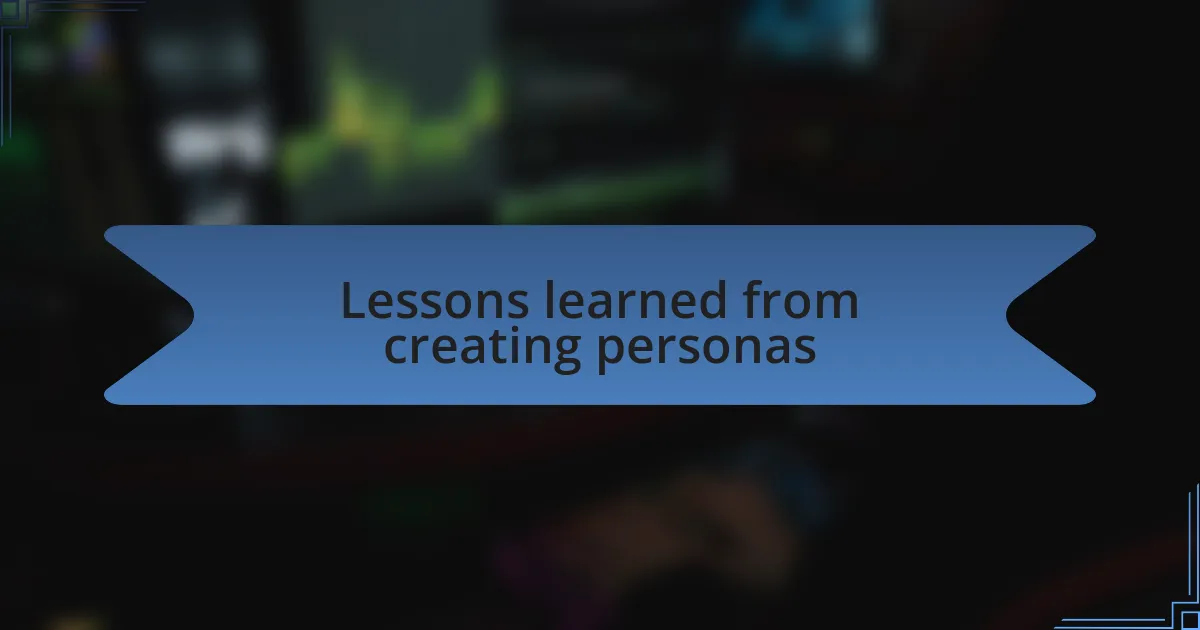Key takeaways:
- Empathy is crucial in creating user personas, shaping design and functionality to better address users’ needs.
- Gathering and analyzing user feedback helps identify common frustrations and informs targeted solutions.
- User personas serve as essential tools throughout product development, guiding decisions and fostering a user-centered mindset within teams.
- Personas are dynamic and should be regularly revisited to adapt to changing user needs and insights.

Understanding user personas
Understanding user personas is fundamentally about stepping into the shoes of our users. When I first created personas for my products, it felt a bit daunting, as I was trying to capture the essence of different users based on real data. However, I quickly discovered that these personas were not just fictional characters; they became my guides, shaping every design and development decision I made.
I remember vividly the moment I realized the importance of empathy in this process. One user persona I crafted was a busy young professional, constantly juggling multiple tasks. Reflecting on my own life, I could relate to that pressure. This connection encouraged me to prioritize features that simplified their experience. It raised a vital question: How can our software genuinely save them time and energy?
Through interviews and surveys, I gathered insights that added depth to my personas. Each story revealed a layer of frustration or need, which fueled my passion for creating solutions that truly resonate. It’s fascinating to think how understanding someone’s daily struggles can lead to software that doesn’t just meet a functional requirement but actually enhances their life. What if we focused more on these human experiences? The outcomes could be transformative.

Importance of user personas
Creating user personas is not just an exercise; it’s a crucial step in ensuring your product is user-centric. I recall the first time I mapped out a persona based on user feedback. It felt like holding a mirror up to the people I intended to serve. Each persona illuminated the unique challenges and preferences that I might have missed otherwise. It prompted me to ask, “What specific pain points am I resolving for this user?”
The emotional connection I formed with my personas transformed my approach to software development. For example, while developing a project management tool, I had a persona who struggled with burnout. This realization guided me to integrate features that promote work-life balance. I wondered: how could my software help users reclaim their time? The answers led me to create functionalities that encouraged breaks and prioritized tasks, ultimately fostering a healthier work environment.
User personas serve as a constant reminder of who we’re building for. I often revisit these profiles during various stages of development, asking myself if the decisions I’m making align with their needs. For instance, when considering a new feature, I think, “Would this truly benefit my user? Do they even need it?” This practice not only refines my focus but also reinforces a culture of empathy within my team, emphasizing that the user experience is at the heart of what we do.

Steps to create user personas
Creating user personas starts with gathering data on your target audience. I often recommend conducting surveys or interviews to collect valuable insights. When I first ventured into collecting user feedback, the results revealed unexpected patterns that reshaped my understanding of who my users truly were. Have you ever been surprised by feedback that completely changed your perspective?
Next, I analyze this data to identify distinct segments and characteristics shared among users. This can involve demographic details, motivations, and challenges they face. During one project, I discovered that two seemingly different user groups had similar frustrations with time management. It was a revelation that prompted me to unify their needs into one cohesive persona. Being able to rationalize my decisions based on shared insights made my development process feel far more targeted.
Once I outline these characteristics, I give each persona a name, background, and specific goals. I can vividly recall creating a persona named “Diana the Overwhelmed Manager.” Every decision I made felt more personal, as if I was crafting solutions specifically for Diana’s world. How does naming your personas change your approach? For me, it turns user research into a powerful storytelling tool, reminding me to always keep the “human” element at the forefront of my designs.

Tools for creating personas
Various tools can significantly enhance the process of creating user personas. For instance, I’ve found that platforms like UserTesting and Typeform streamline the gathering of user feedback, making it easier to extract meaningful insights. When I first used Typeform for a survey, the clean interface not only boosted response rates but also surprisingly provided me with real-time analytics that shaped my personas almost instantaneously. Have you ever felt the thrill of unveiling user perspectives right before your eyes?
Another valuable resource is the persona creation software, such as Xtensio or HubSpot’s Make My Persona. These tools allow you to visualize your personas vividly, providing templates that guide you through key sections like demographics, needs, and pain points. I remember feeling a sense of clarity when I filled out a template on Xtensio for my last project; seeing all the information organized beautifully made it easier to align my development strategy with real user behavior. Isn’t it intriguing how visualization can transform raw data into a compelling narrative?
Lastly, leveraging collaboration tools like Miro or Trello can be tremendously helpful for brainstorming and refining personas with your team. During one development cycle, we used Miro’s collaborative space to dissect user feedback together, leading to a rich exchange of ideas that birthed more nuanced personas than any one of us could have created alone. How often do we underestimate the power of working together? It’s when diverse insights collide that truly innovative personas emerge.

Analyzing persona data
Analyzing persona data requires diving deep into the patterns and trends that emerge from user interactions. I vividly remember when I sifted through user feedback after a beta test; uncovering a recurring theme in frustration about a specific software feature led me to rethink its design entirely. Have you ever unearthed a crucial insight that made you rethink your approach? It’s moments like these that reveal the true power of persona data.
As I processed the data, I made it a point to categorize insights based on user behavior and preferences. For example, when I discovered that several users valued quick access to customer support, it became clear that my next priority had to be enhancing our help resources. This analysis isn’t just about numbers; it’s about translating these insights into actionable changes that genuinely resonate with users.
Despite the complexity of the data, I found storytelling to be an effective way to clarify my findings. Creating narratives around key personas helped communicate insights across my team and shaped our development goals. When data merged with storytelling, my colleagues were not only on board with decisions but also inspired to contribute. Isn’t it fascinating how turning data into relatable stories can elevate an entire project’s focus?

Applying personas in product development
Applying personas in product development transforms the way we approach design and functionality. For instance, when I created a persona named “Tech-Savvy Tara,” it illuminated certain features that needed refinement. Tara preferred intuitive navigation, which prompted me to streamline our user interface significantly. Have you ever changed a feature just because one user persona highlighted its importance?
Integrating personas into our product cycle unlocked a more user-centered mindset within our team. I vividly recall a brainstorming session where we discussed a new feature aimed at our “Small Business Sam” persona. Listening to my team passionately debate how this feature could alleviate Sam’s day-to-day challenges was powerful. Their insights were as valuable as any data points; they were imagining real solutions for real people, which made our development goals feel purposeful.
Moreover, I found that personas can serve as a guiding star during product iterations. For example, I used “Budget-Conscious Brenda” to keep our pricing discussions in check. Whenever pricing options were proposed, I would ask my team, “How does this serve Brenda’s need for affordability?” Suddenly, each decision felt more accountable, steering us clear of features that might dazzle but alienate our core user base. It’s moments like these that reinforce why personas are essential—they keep us aligned with user needs throughout our development journey.

Lessons learned from creating personas
Creating personas taught me the importance of empathy in design. When I developed the persona “Busy Brenda,” who juggles multiple tasks, it hit me how vital it is to understand users’ pain points. Reflecting on Brenda’s experience led me to prioritize features that reduce friction and save time. Have you considered how deeply understanding your users can shift your entire development approach?
I also realized that personas can spark invaluable collaboration across teams. During one project, a developer mentioned feeling disconnected from the end-users. When we presented our persona “Freelancer Frank,” who was facing unique challenges, I saw an immediate shift in his perspective. Engaging with Frank’s story ignited a passion in him that I hadn’t seen before, fostering a stronger connection to the project. Isn’t it fascinating how a well-crafted persona can humanize data points, turning mere statistics into narratives that resonate?
Lastly, I learned that personas are not static; they evolve. While working on our product, I revisited “Tech-Savvy Tara” after user feedback highlighted gaps in her needs. This iterative process taught me to remain adaptable and open-minded. It’s a reminder that user-centered design is less about rigid definitions and more about a continuous journey of discovery. How often do we revisit our assumptions about users? Keeping this in mind has profoundly impacted how I view our development process.